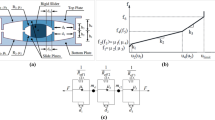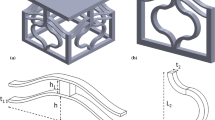Abstract
Galloping phenomenon is one of the vibrations caused by icing. If galloping phenomenon continues, short-circuit or ground fault may occur, so analysis of galloping phenomenon through research on transmission line stability is necessary. The DenHartog method, which is frequently used for the galloping stability determination of the transmission line, considers only the vertical movement of the transmission line. In this study, we analyze the motion of multi-degree-of-freedom objects, using a computer aided engineering program. We modeled transmission lines as a multi mass-spring-damper systems using RecurDyn, which is a multibody commercial dynamics analysis program to analyze the galloping phenomenon dynamically. Damping inside transmission line derived from the Rayleigh damping theory through the free vibration experiment of transmission line. ANSYS Fluent, a flow analysis program, was used to derive the aerodynamic coefficients for transmission line with asymmetric cross-section. Using the derived aerodynamic coefficient, we confirmed the galloping occurrence condition of DenHartog method and modeled the wind load acting on the transmission line to conduct galloping simulation. Through the analysis of the motion of a multi-degree-of-freedom transmission line, the occurrence of galloping was classified into ovoid and vertical trajectories, and the case of no galloping was defined as regular trajectory, and the range of angle of attack that causes the instability of transmission lines was defined.









Similar content being viewed by others
References
Kwak, M. K., & Shin, J. H. (2016). Dynamic modeling and experiment of transmission line for prevention of galloping phenomenon occurring in transmission line. Journal of Korean Society for Noise and Vibration Engineering, 26(2), 10–p17.
Koo, J. R., & Bae, Y. C. (2015). Protection method of ice and snow failure at the power transmission line. In Proceedings of the Korean society for noise and vibration engineering (Vol. 2015, No. 4, pp.735–738).
Wang, J., & Lilien, J. L. (1998). A new theory for torsinal stiffness of multi-span bundle overhead tranmission lines. IEEE Transactions on Power Delivery, 13(4), 1405–1411.
Hu, J., Song, Z., Ma, J., & Wu, S. (2006). Model for comprehensive simulation of overhead high voltage power transmission line galloping and protection. In Annual report conference on electrical insulation and dielectric phenomena (pp.190–193).
Cho, J. U., & Han, M. S. (2011). Study on the vibration analysis of damper clutch spring. Journal of the Korean Society of Manufacturing Process Engineers, 10(4), 22–30.
Kim, Y. J., Ro, S. H., Shin, H. B., Jung, K. S., & Nam, K. D. (2016). Effects of design alterations on the vibration suppression of a machine tool structure. Journal of the Korean Society of Manufacturing Process Engineers, 15(3), 122–129.
Davison, A. E. (1930). Dancing conductors. Transactions of the American Institute of Electrical Engineers, 49(4), 1444–1449.
DenHartog, J. P. (1932). Transmission line vibration due to sleet. Transactions of the American Institute of Electrical Engineers, 51(4), 1074–1076.
Nigol, O., Buchan, P. G. (1981). Conductor galloping part 1—denhartog mechanism. Transactions on Power Apparatus and Systems, PAS-100(2).
Nakamura, Y. (1980). Galloping of bundled power line conductors. Journal of Sound and Vibration, 73(3), 363–377.
Lou, W., Wu, D., Xu, H., & Yu, J. (2020). Galloping stability criterion for 3-DOF coupled motion of an ice-accreted conductor. Journal of Structural Engineering, 146(5), 04020071.
Mou, Z., Yan, B., Lin, X., Huang, G., & Lv, X. (2020). Prediction method for galloping features of transmission lines based on FEM and machine learning. Cold Regions Science and Technology, 173, 103031.
Kim, J. W., & Sohn, J. H. (2018). Multibody dynamics study on galloping of power transmission line. Journal of Mechanical Science and Technology, 32(8), 3597–3602.
Munson, B. R., Young, D. F., Okiishi, T. H., & Huebsch, W. W. (2007). A brief introduction to fluid mechanics (4th ed.). Hoboken: Wiley.
Den Hartog, J. P. (1956). Mechanical vibration. USA: McGraw-Hill.
Nikitas, N., Macdonald, J. H. G. (2014). Misconceptions and generalizations of the Den Hartog galloping criterion, Journal of Engineering Mechanics, 140 (4).
Singiresu S. R. (2012). Mechanical vibrations fifth edition in SI units, PEARSON, USE.
Alipour, A., & Zareian, F. (2008). Study Rayleigh damping in structures Uncertainities and treatments. In Proceedings of 14th word conference on earthquake engineering, Beijing, China.
Kim, J. Y. (2014). A behavior prediction of automotive exhaust system considering Rayleigh damping, Master’s Thesis of Graduate School of Hanyang University.
Kim, J. H. (2003). Experimental study of beam and plate large deformation, Master’s thesis of Graduate School of Pusan National University.
Hibbleler, R. C., Yap, K. B. (2015). Engineering mechanics: Statics 13th Edition. USA: Pearson.
Kim, J. M. (2017). Wind tunnel test for aerodynamic characteristics of transmission line, Graduate School of Kyungil University.
CIGRE Technical Brochure, State of the art of conductor galloping, No. 322, Task Force B2.11.06, 2007.
Author information
Authors and Affiliations
Corresponding author
Additional information
Publisher's Note
Springer Nature remains neutral with regard to jurisdictional claims in published maps and institutional affiliations.
Rights and permissions
About this article
Cite this article
Oh, YJ., Sohn, JH. Stability Evaluation of the Transmission Line by using Galloping Simulation. Int. J. Precis. Eng. Manuf. 21, 2139–2147 (2020). https://doi.org/10.1007/s12541-020-00399-5
Received:
Revised:
Accepted:
Published:
Issue Date:
DOI: https://doi.org/10.1007/s12541-020-00399-5




